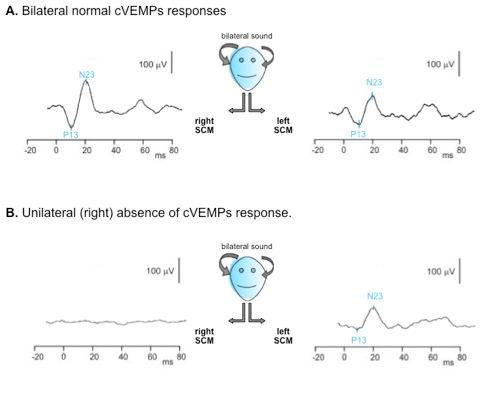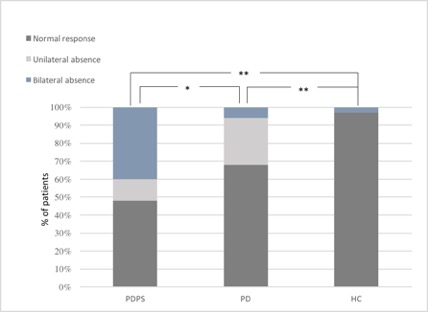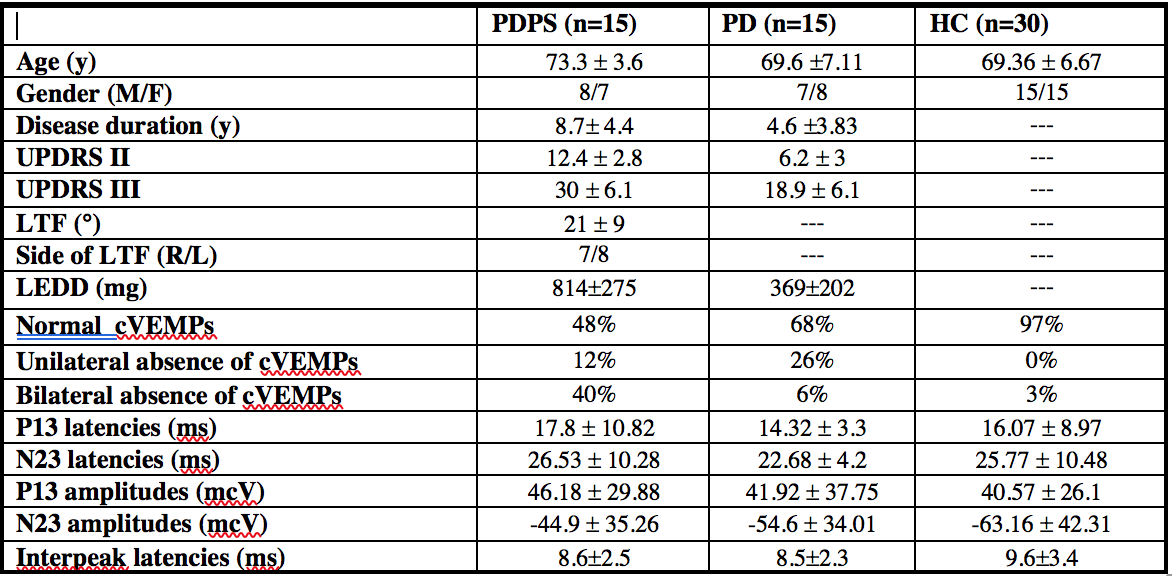Session Information
Date: Monday, October 8, 2018
Session Title: Parkinson's Disease: Neuroimaging And Neurophysiology
Session Time: 1:15pm-2:45pm
Location: Hall 3FG
Objective: To evaluate vestibular involvement in patients with Parkinson’s disease and postural abnormalities.
Background: Pisa syndrome (PS) is a peculiar postural complication typically occurring at later disease stages of Parkinson’s disease (PD). Its pathophysiology is unclear, although a multifactorial component is probable. Cervical Vestibular Evoked Myogenic Potentials (cVEMPs) test vestibulo-collic reflex. They have been recently used as an index of brainstem integrity in several neurophysiological studies on neurodegenerative conditions but they have not yet been measured in PD patients with PS (PDPS) to assess a potential vestibular impairment.
Methods: We enrolled 15 PD patients, 15 PDPS patients and 30 healthy controls (HC). They underwent neurological examination and were assessed with Unified Parkinson’s Disease Rating Scale II-III (UPDRSII-III), audio-vestibular work up and cVEMP recordings. Data were analyzed with Chi-square, one-way ANOVA, multinomial regression, non-parametric and Spearman’s tests.
Results: Groups did not significantly differ in age, gender and auditory testing. The main alteration observed in cVEMPs within the PD groups was the unilateral or bilateral absence of evoked potentials. Chi square analysis demonstrated that normal cVEMPs were significantly reduced in both PD and PDPS compared to HC (respectively p<0.001 and p<0.001). However, the pattern of cVEMPs abnormalities significantly differed between PDPS and PD (p<0.0001), with PDPS showing lower normal responses (p<0.05) and more frequent "bilateral absence" (p<0.0001); otherwise "unilateral absence" was more common in PD than PDPS (p<0.05). Finally, correlation analysis between neurophysiological and clinical parameters did not provide any significant result among groups.
Conclusions: Here, we demonstrate that PD patients, compared to HC, have significantly abnormal vestibular evoked responses. Furthermore, the neurophysiological profile differs between PD subgroups: PD mostly exhibits the unilateral absence of cVEMPs, whereas PDPS shows prevalently bilateral loss of responses. These data may thus reflect the progression of vestibular dysfunction and brainstem neurodegeneration along disease course, with a progressive worsening in advanced stages, when postural complications are more frequently observed. Our results provide evidence for a significant impairment of cVEMPs in PDPS patients and encourage further studies to test validity of cVEMPs as diagnostic and prognostic biomarker of PD progression.
References: J. G. Colebatch, G. M. Halmagyi, and N. F. Skuse, “Myogenic potentials generated by a click-evoked vestibulocollic reflex.,” J. Neurol. Neurosurg. Psychiatry, vol. 57, no. 2, pp. 190-7, Feb. 1994 E. R. de Natale, F. Ginatempo, K. S. Paulus, A. Manca, B. Mercante, G. M. Pes, V. Agnetti, E. Tolu, and F. Deriu, “Paired neurophysiological and clinical study of the brainstem at different stages of Parkinson’s Disease,” Clin. Neurophysiol., vol. 126, no. 10, pp. 1871-1878, 2015.
To cite this abstract in AMA style:
G. Di Lazzaro, T. Schirinzi, S. Di Girolamo, R. Di Mauro, A. Pisani. Pisa syndrome in Parkinson’s disease: Evidence for bilateral vestibulospinal dysfunction [abstract]. Mov Disord. 2018; 33 (suppl 2). https://www.mdsabstracts.org/abstract/pisa-syndrome-in-parkinsons-disease-evidence-for-bilateral-vestibulospinal-dysfunction/. Accessed January 1, 2026.« Back to 2018 International Congress
MDS Abstracts - https://www.mdsabstracts.org/abstract/pisa-syndrome-in-parkinsons-disease-evidence-for-bilateral-vestibulospinal-dysfunction/



